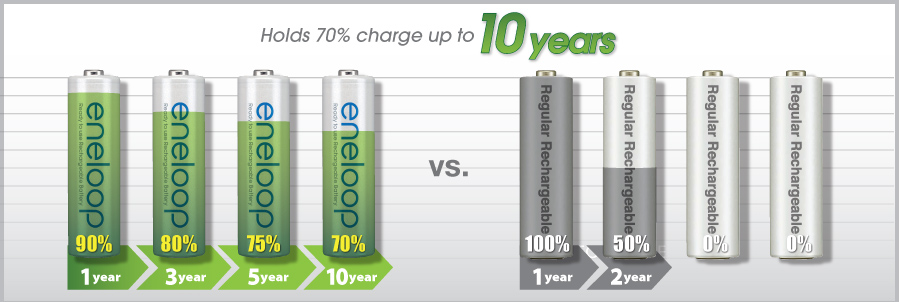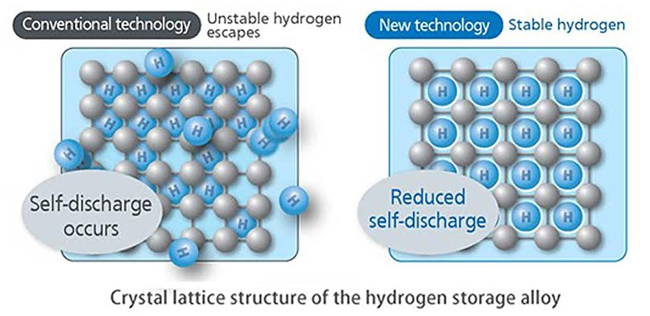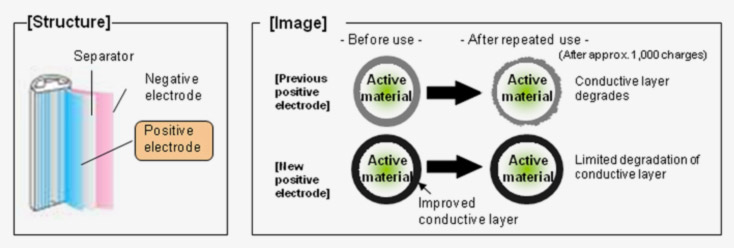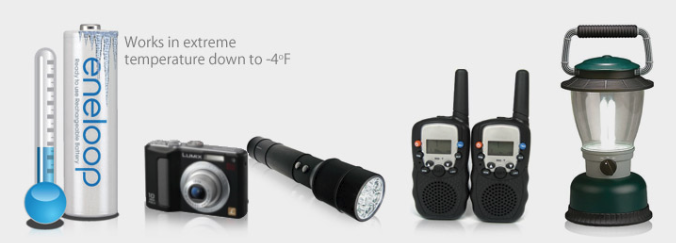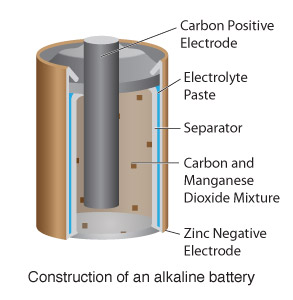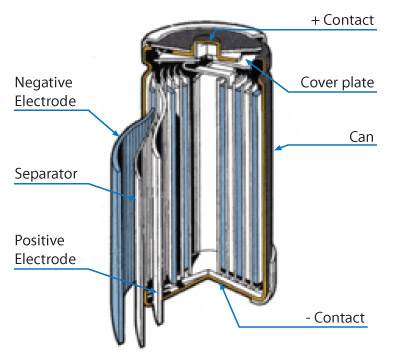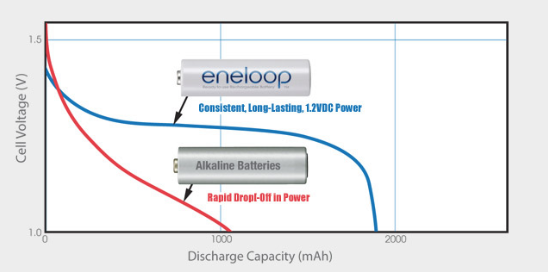
 eneloop Rechargeable Batteries Power Pack
eneloop Rechargeable Batteries Power Pack
Part# K-KJ17MCC82A
eneloop Ni-MH “Low Self Discharge” batteries utilize Panasonic’s advanced rechargeable battery technology allowing them to be recharged up to 2100 times**.
eneloop battery cells deliver consistent power performance, maintain 70% of their charge for up to 10 years*, come pre-charged by solar power (at the factory)*** and are ready to use out of the package. These eneloop cells also have increased storage life and extreme temperature performance down to -4° Fahrenheit.****
These battery cells are ideal for all household products including flashlights, wireless gaming devices, digital camera flash units, and wireless mouse and keyboards.
What Makes eneloop so Amazing?
eneloop batteries utilize a highly-durable super lattice alloy which prolongs the life of this important material. Improvements to this super-lattice alloy have increased hydrogen stability resulting in reduced self-discharge and long lasting, stable voltage output.
Improvements to the conductive surface layer of the active (positive) electrode material (made primarily from nickel-metal hydride) produce greater conductivity and durability. By limiting the degradation of the conductive layer, it has been possible to reduce performance degradation during repeated use and thus increase the number of times that eneloop batteries can be recharged – all without increasing the amount of negative electrode alloy used.
eneloop Ready to Use Rechargeable Batteries
A strong, thin outer casing also provides improved internal cell space efficiency of the eneloop battery design. This battery shell optimizes the balance of the components and when combined with the improved alloy material and conductive surface layer of the positive electrode active material enables the new eneloop cells to be recharged up to 2100 times.**
eneloop Ready to Use Rechargeable Batteries are Pre-Charged with Solar Power
eneloop’s unique “Clean Energy Loop” initiative is a reality. All eneloop and eneloop pro batteries are pre-charged at the factory in Japan using power generated from solar energy.*** This process is certified twice a year by The Green Energy Certification Center.
eneloop = Lower Cost of Ownership
eneloop offers a lower cost of ownership saving, as much as $1000 per cell vs. regular Alkaline batteries.
Each eneloop cell can cost less than 4 cents per recharge.

*eneloop Recharge Cost Assumptions and Calculations
0.144 Kilowatts @ 8 hours
4 eneloop AA — 2100 recharges
2100 cycles x 8 hours changing time = 16,800 hours of AC power
0.144 KW x 16,800 hours = 2,419.20 KWH
2,419.20 KWH x $0.12 = $290.30
Initial Product Cost = MQN064 (4AA + charger) @ $29.99 MSRP; Charger $14.99, total battery at $3.75/cell
TOTAL COST OF PRODUCT and RECHARGING = $290.30 + $29.99 = $320.29
TOTAL NUMBER OF RECHARGE CYCLES = (4 batteries x 2100 each) = 8400 recharges
COST PER RECHARGE = ($320.29/8400) = $0.038 (.038 cents PER RECHARGE)
NOTE: Cost of electricity is based on 2013 US average energy costs @ $0.12 per KWH (as calculated by US Energy Information Administration).
Why Are Alkaline Batteries 1.5V?
Regular disposable AA and AAA batteries are considered Primary Cells, more widely recognized as conventional “alkaline” batteries. There are two electrodes inside each cell; one is made of Zinc, known as the anode (the negative terminal) and the other is made of Manganese Dioxide, known as the cathode (the positive terminal). The electrodes are surrounded by an alkaline electrolyte, the chemical from which alkaline batteries get their name.
Battery chemistry of an alkaline battery generates 1.5V. As the chemical reaction fades, so does the power of the alkaline battery cell. This is why the voltage from alkaline batteries drops off shortly after the battery is put into use and the power continues to fade over time.
Why Are Ni-MH Batteries 1.2V?
Ni-MH rechargeable batteries have two electrodes inside the cell: Nickel Hydroxide and Hydrogen absorbing alloy. Battery chemistry of a Ni-MH rechargeable battery generates 1.2V. While alkaline batteries experience rapid drops in voltage Ni-MH rechargeable batteries maintain the same voltage throughout most of the entire charge.
The chemical makeup of Ni-MH batteries allows the cell to be recharged at any time without having to be fully discharged.
eneloop batteries have continued to raise the performance bar in Ni-MH rechargeable technology. They have increased “low self-discharge” performance on Ni-MH rechargeable batteries which allows eneloop cells to store power for longer periods of time.
Since alkaline cells are non-rechargeable, they must be discarded and then replaced. eneloop batteries deliver best-in-class Ni-MH high capacity power and “rechargeability” combination up to 2100 times.** Devices including cameras flash units and wireless game controllers can easily draw more than 1000mA of current, rapidly depleting alkaline batteries power. eneloop batteries maintain a consistently high voltage level keeping your devices operating for a long period of time. When you use eneloop Ni-MH rechargeable batteries, you will realize that “1.2V” can indeed be better than “1.5V”.
eneloop has two “new” authentic styles of packaging:
- The new eneloop 2100 cycle batteries are packaged in a blue/green cardboard blister pack (shown below).
- The new eneloop pro in black and silver (shown below).
- eneloop 1800 and 1500 cycle batteries which were packaged in a blue/green cardboard blister design with an earth image screened on the package (are former packaging 2nd and 3rd generation products).
- eneloop 1000 cycle batteries which were packaged in a blue and orange cardboard blister (1st generation product).
- eneloop XX batteries are packaged in a black cardboard blister package (1st generation product).
Products sold in plastic bags or flexible foil style packages are not authorized for sale in the U.S. and may not contain authentic eneloop batteries.
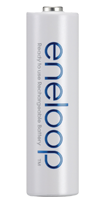 |
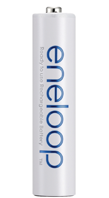 |
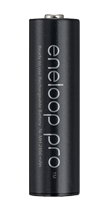 |
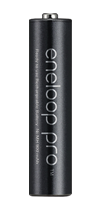 |
|
| Battery Size | AA | AAA | AA | AAA |
| Capacity | up to 2000mAh* | up to 800mAh* | up to 2550mAh* | up to 950mAh* |
| Cycles / Recharges | up to 2100 times** | up to 2100 times** | up to 500 times** | up to 500 times** |
| Storage Life | Holds 70% charge up to 10 years* | Holds 70% charge up to 10 years* | Hold 85% charge up to one year* | Hold 85% charge up to one year* |
| Charged at the Factory Using Solar Power | Yes | Yes | Yes | Yes |
| Low Temp Rating | Down to -4 degrees F | Down to -4 degrees F | Down to -4 degrees F | Down to -4 degrees F |
| Chemistry | LSD Ni-MH | LSD Ni-MH | LSD Ni-MH | LSD Ni-MH |
| Recyclable | Yes | Yes | Yes | Yes |
| Weight | .952 | .459 | 1.058 | .508 |
| Size | 0.57” x 1.99” | 0.41” x 1.75” | 0.57” x 1.99” | 0.41” x 1.75” |
| Voltage | 1.2v | 1.2v | 1.2v | 1.2v |
| Country of Origin | Made in Japan | Made in Japan | Made in Japan | Made in Japan |
Batteries can be recharged when fully, or partially drained. *eneloop charge capacity and mAh estimates based on Panasonic internal IEC 61951-2(7.3.2) testing. **Recharge cycles based on testing method established by IEC 61951-2(7.5.1.3). ***Solar energy charging as certified by The Green Energy Certification Center. eneloop batteries need a charger to be recharged. Panasonic Ni-MH battery chargers are recommended. ****Recommended storage conditions 68 degrees F. Results may vary based on conditions of storage and use.

